Moderators if this topic is out of bounds I will not repeat it. I understand you do not want to divert the blog to debates over "fantasy ships". This post raises the possibility of expanding the usage of existing ships, namely the LPDs Adelaide and Canberra.
I was reading recently of the Turkish Navy's efforts to turn their new LPD, the Anadolu, into a "drone carrier". As everyone knows, Turkey has been a major UAV drone supplier to Ukraine, with the Bayraktar TB2 being highly successful. The TB2 is small and has limited speed and payload, so I assume would not be suitable for long range sea missions. However the same manufacturer is making a larger, faster, longer range drone, with larger payloads, suitable for naval use from the new Turkish LPD, the Anadolu. The big drone is called the Akinci, which has started flying. See
Turkey’s landmark combat drone Akıncı on Wednesday underwent a successful flight test with upgraded engines that make it the most advanced platform in...

www.dailysabah.com
The Andalou is shown here. as you can see, it is literally sister-ship of the Adelaide and Canberra.
Sea tests began for Turkey’s multipurpose amphibious assault ship TCG Anadolu, according to an official from the shipyard that undertook the project...

www.dailysabah.com
The concept is discussed here. The TB3 is a naval version of the TB2.
Prologue: This article was first published in Defence Turkey Magazine Issue 106. It is not a secret that Turkey intends to operate an aircraft carrier. This desire was made public by President Erdo…

turkishnavy.net
Some have suggested flying F35Bs off Adelaide and Canberra. My understanding is that the RAN LPDs have not been fitted with the many design features that would be needed to sustain that use and so I consider it unrealistic. The obvious advantage of the "drone carrier" approach is that the Akinci is much lighter than an F35B, similar to a helicopter in weight (Max TOL 5.5 tonnes). This is about half the TO weight of an SH60. The max. payload is still only 1.35 tonnes, so this will hardly turn the LPDs into real "carriers" but more importantly it can fly for 25 hours and cruise at 240 km/hr, so it has a huge range (7500km). This would give it a genuine ISR capability, perhaps linked to Tomahawks on AWDs, plus firing the occasional PGM. This might make a half dozen Akincis on an LPD quite useful. The Akinci's would cost $80 million US for 3, cheaper than a single F35B.
Apologies if I am barking up the wrong tree, but I wonder if something like this, integrated into existing RAN ships and systems, might be quite helpful to the RAN?









